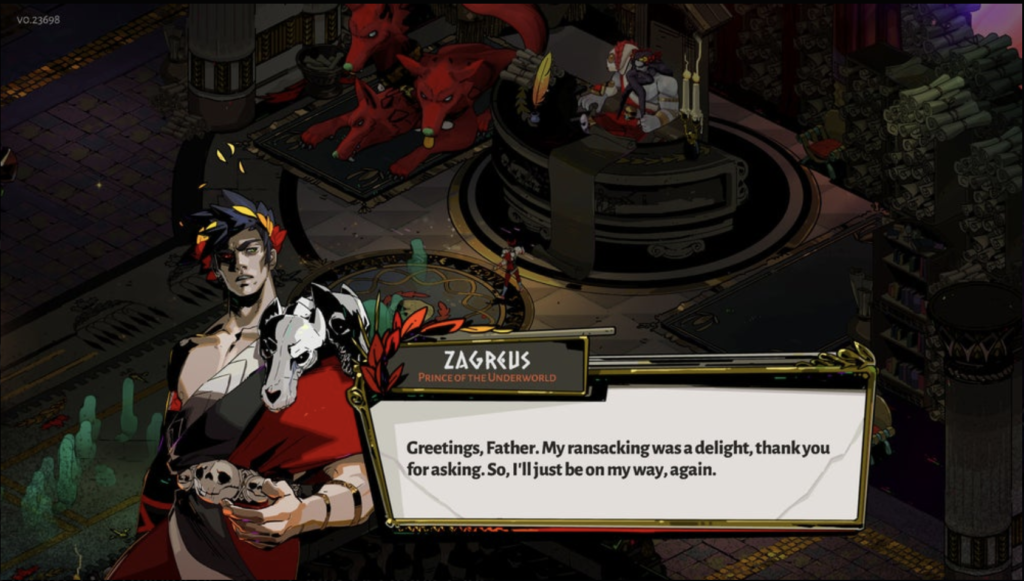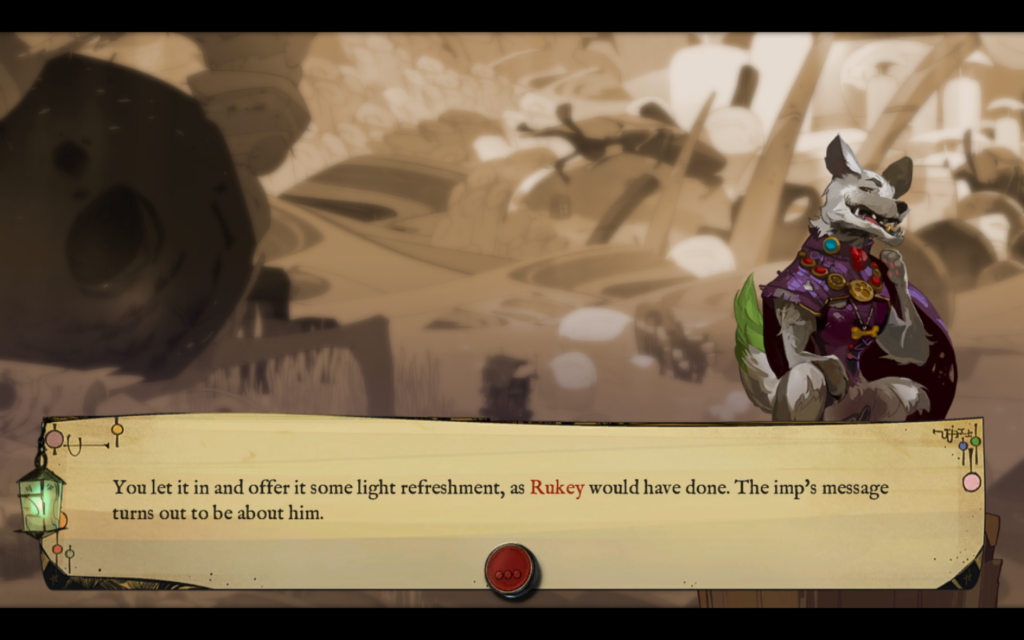In class, I instantly said “Pyre is a rogue-like” when I was asked what kind of genre it was. When I was pressed for more information, I immediately folded. Why was “rogue-like” the genre I immediately thought of in regards to possible genres Pyre encompassed? After mulling over it (over a few failed Pyre rites), I came to my conclusion. The reason that I thought of the rogue-like genre immediately was because of Pyre’s close relationship with Hades, another game developed by Supergiant.
On the surface, Pyre and Hades are pretty different games. Pyre is a sports/visual novel game hybrid with original characters, no fail state, and a story that adapts to the player’s decisions, wins, and losses. Hades is an action rogue-like with visual novel elements based off of Greek Mythology, and a much more linear story. Hades does allow for players to experience the story in a mostly non-linear way, but the story itself is still centered around Hades’, Persephone’s, and Zagreus’ relationship, and there aren’t any branching paths in the main story. But there’s actually a lot that feels the same between the games.

It feels like you could do rogue-like “runs” in Pyre very easily. Focusing and building on a specific type of team in Pyre felt like collecting the perfect boons and upgrades in a Hades run. Freeing an exile almost feels like starting a new run, restarting with characters you weren’t as experienced with and helping them succeed instead. You get to choose where you go (after the first rite) and challenge teams according to your wants as a player, crafting the story to your will.
The visual novel aspect is another easy way to draw a connection. Hades and Pyre both involve a TON of reading, have rich voice acting (hello Logan Cunningham), and a witty narrator egging the player on. The UI design for both feels very similar; the sound effects and visuals when confirming a choice feel similar. The art style is different, but you can see that these games were created by the same developer.

This is the main point I’m trying to get at. Hades and Pyre feel like they share a genre because they were created by the same developer. In an interview with director Amir Rao and writer and designer Greg Kasavin, they stated:
“Hades would not be possible… without the games that came before it and the specific people who made them. It’s a reaction to Pyre, which was a reaction to Transistor, which was a reaction to Bastion.”
All of Supergiant’s games are intrinsically tied to each other because the people working on them have similar ideas. The genre that Hades and Pyre share is not really a genre. It’s the simple fact that they were made by the same developer. This phenomenon isn’t localized to Supergiant, as it’s very popular to define games by their developer.

Nintendo games all typically share that kid-friendly, accessible to everyone feel. Think Wii Sports, Mario Kart, Nintendo World, and Smash Bros., among others. They’re all designed to gather multiple people around a single TV, and have simple fun with friends. Spike Chunsoft games, such as 9 Hours, 9 Persons 9 doors, Danganronpa, and AI: the Somnium Files all are narrative focused games that revolve around solving an overarching mystery. Each is distinct in their own way, but similarities can be drawn between the games. Blizzard focuses on creating games with a constant stream of updates for a long time, such as World of Warcraft, Starcraft, and Overwatch. The list goes on and on. Bungie’s Halo and Destiny, Riot games League of Legends and Valorant.
It makes sense that developers make similar games, and I think that it offers another creative way to categorize games in a genre that we haven’t really talked about before. Pyre might not really be a rogue-like game, but it sure as hell is a Supergiant game.
Source: https://kotaku.com/the-secret-to-the-success-of-bastion-pyre-and-hades-1838082618


I really like this post, because it presents an argument for a cultural genre that almost entirely transcends a game’s mechanics and appearance. And it feels like an important point to make because games are not strictly inspired by the genre(s) that they belong to. As you mentioned, a company that is trying to publish a specific brand of games will have completely different games mechanically, but will still have the same game feel. Riot Games focuses on games with depth and competitive value that can be extremely fun to play while also being extremely frustrating. As such, they are notorious for their toxic playerbase, between both League of Legends, a MOBA, and Valorant, a tactical first-person shooter. Development teams also should seem like an intuitive idea, since films or novels are also typically categorized by prolific directors or authors.
!!! This is a great and interesting idea as development teams do play a huge part in determining the game feel and the general style of games, which arguably could make them a way of classifying genre. This is similar to how in films sometimes you can just advertise a film by saying e.g., “this is a Christopher Nolan film”, and people will understand what that means. Also, it’s interesting to inquire when we are describing works by their producers’ names, what specific aspects do they refer to? Like when we say “this is a Supergiant game”, what do we expect the listeners to infer from this term? Does it refer to a specific art style, way of game design, quality of the game, or anything else? And among the same narrative/mechanical genre, what makes this development team’s name stand out?
I really like this post as well! It seems to clarify and point out something that we already take for granted in lots of other genres–game development teams can absolutely have a _style_, just in the same way that authors, directors, and visual artists can. Studio Ghibli is famous for its fluid, expressive animation and, typically, stories of coming of age, nature, and love. Wes Anderson movies are famous for being quirky and twee, Octavia Butler wrote a lot of mind-bending stories about human/alien relationships, and so on and so forth. So, like, of course game studios can have a style, it’s just almost as though we don’t really realize it. I think this might be because, in video games, singular “auteurs” are a bit more rare. Miyazaki is the most prominent artist behind Ghibli, but there’s not quite a most prominent figure behind Supergiant. Nintendo might have Miyamoto, but after a certain point he took a creative backseat at the company, and yet many of their games continue with the same style. This–that is, not recognizing game studios’ distinctive styles–is a bit of a shame, because I personally think that the auteur theory is incredibly flawed, and that, if anything, we should be celebrating the incredible, often extraordinarily collective work that is game development.